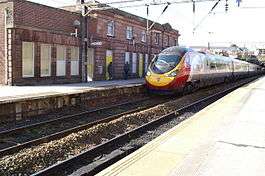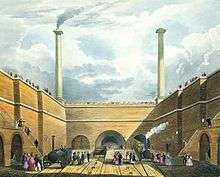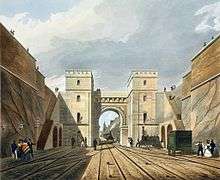Edge Hill railway station
Edge Hill railway station serves the district of Edge Hill, Liverpool, England.
| Edge Hill | |
|---|---|
 | |
| Location | |
| Place | Edge Hill |
| Local authority | Liverpool |
| Grid reference | SJ371899 |
| Operations | |
| Station code | EDG |
| Managed by | Northern Trains |
| Number of platforms | 4 |
| DfT category | E |
| Live arrivals/departures, station information and onward connections from National Rail Enquiries | |
| Annual rail passenger usage* | |
| 2014/15 | |
| – Interchange | |
| 2015/16 | |
| – Interchange | |
| 2016/17 | |
| – Interchange | |
| 2017/18 | |
| – Interchange | |
| 2018/19 | |
| – Interchange | |
| Passenger Transport Executive | |
| PTE | Merseytravel |
| Zone | C1 |
| History | |
| 1836 | Opened |
| National Rail – UK railway stations | |
| * Annual estimated passenger usage based on sales of tickets in stated financial year(s) which end or originate at Edge Hill from Office of Rail and Road statistics. Methodology may vary year on year. | |
There have been two stations of that name. The first stood a short distance south-west of the present station and its remains are still visible, although the site is not open to the public.
Edge Hill is the first station after departure from Liverpool Lime Street. The station, and all trains serving it, are operated by Northern Trains.
Avanti West Coast, East Midlands Railway, TransPennine Express and West Midlands Trains services pass through the station, but do not stop.
The first station

The first station opened on 15 September 1830 as part of the Liverpool and Manchester Railway.[1] It was located in a 22 yd (20 m) wide by 68 yd (62 m) long, 40 ft (12 m) deep sandstone cutting, with three tunnels at the west end.[2]
The largest bore, in the centre, was the 2,250 yd (2,060 m) Wapping Tunnel, a long downwards incline leading to Wapping Dock and the world's first tunnel to be bored under a metropolis.[1] The tunnel was worked by an endless rope running down the centre of one track and back along the other,[3] the goods wagons descended by gravity, but were hauled up by the stationary steam engine.[4] During the summer of 1829, prior to the tunnel opening for traffic, it became a popular subterranean promenade. It was whitewashed and lit by gas at intervals. On certain days, people could walk through at a cost of 1s a time,[nb 1] there was even a band provided which heightened the excitement of a novel and eerie adventure. On 1 August alone some three thousand people walked its length.[6]
The tunnel to the north of the central bore was much shorter and inclined upwards, leading to the passenger terminal at Crown Street and a coal depot.[7] Here the trains descended by gravity to Edge Hill station and were wound up into Crown Street.[8]
The southern tunnel was originally a short length leading nowhere and used as a storage shed: its chief purpose was to create a symmetrical appearance. In 1832 it was cleared out and used as engine shed during the winters; later it became the waggon[nb 2] repairing shop until 1845 or 1846 when it was extended and expanded to provide two additional tracks into the Crown Street coal depot.[2]

At the opposite end of the station area were two engine houses in the form of towers on either side of the line, which was spanned at this point by the famous Moorish Arch. The arch was decorative with two battlemented towers and decorated masonry forming a grand and impressive entrance to Liverpool. But the arch was also functional and served as a bridge connecting the two engine houses across the deep cutting.[9]
There were engine sheds and workshops cut into the rock either side of the station area, others were fitted up as passengers' waiting rooms and offices, there being no room in the cutting for ordinary buildings.[2]
The engines were supplied with steam from return-flue boilers, two on each side of the tracks in the cutting walls. The smoke was channelled down rock cut flues to tall chimneys – known as the 'Pillars of Hercules' – situated either side of the tunnel entrances.[10] A steam connecting pipe was installed in 1832 enabling either set of boilers to be used for either engine, at the same time a pedestrian subway was installed so that staff could move between the engine houses without having to move through the operating railway.[11]
The station area was mainly used for the marshalling of trains and the coupling and uncoupling of locomotives, but first class passengers could also join the trains here, conveyed by horse-drawn carriages from Dale Street in the city centre.[12]
The new station
As early as May 1831 the Directors had concluded that Crown Street station was too far removed from the centre of Liverpool so they commissioned a survey to be made with a view to finding a way of bringing the railway into the town.[13] George Stephenson produced a plan in June 1831 to provide a line, mainly in a tunnel, from Edge Hill to the cattle market at Haymarket. Liverpool Common Council approved the scheme subject to it being restricted to passengers only and plans were drawn up in October 1831 for submission to Parliament. The Bill received Royal Assent on 23 May 1832, tenders were let and work started in 1833.[13][14]
Parliament had forbidden locomotives to run through tunnels and the railway had therefore to build stationary engines at the top of the incline up from Lime Street.[7] The decision to extend the railway to Lime Street station required the construction of a new station at Edge Hill, situated to the north of the old station so that it was on the new line at the tunnel portal. Plans were approved in December 1834, and a contract for the construction of the new station and engine houses was let in March 1835. The new station was about 500 ft (150 m) by 100 ft (30 m) in area with stone platforms with all the station buildings set back from the platform edges.[15]
Trains descended to Lime Street by gravity under the control of two brakesmen riding in an open brake waggon,[16] being rope-hauled by a winding engine back up to Edge Hill. This system, constructed by Mather, Dixon and Company under the direction of John Grantham, ended in 1870.[17][18]
The new Edge Hill station was opened in 1836 and has been in continuous use ever since.[1][19]
Sidings to the north of the station (sometimes called Exhibition Road after the adjacent thoroughfare leading to the exhibition hall) served as a terminus for excursionists visiting the 1886 "Shipperies" and 1887 Royal Jubilee Exhibitions.
The venue on Edge Lane had its own sidings to the south, including access to the building itself, for delivery of exhibits and removal of materials when the site closed.[20]
Layout
Facing west there are two tunnels visible from the platforms. The northernmost tunnel is the Waterloo Tunnel, and the southern tunnel leads to Liverpool Lime Street. The station consists of two island platforms, each with an original building dating from 1836. This makes it one of the world's oldest passenger railway station still in use,[1] although the former Liverpool Road station in Manchester is the oldest surviving station building. Art exhibitions are held on the approach road to the Southern island platform. An arts centre called Metal now occupies part of the building on the Manchester-bound platform.
Around 400 yards[nb 3] from the station in the Manchester direction is a key junction, where the Merseyrail City lines separate into two: one goes towards Mossley Hill (serving the southern Liverpool-Manchester line and the West Coast Main Line) and the other towards Wavertree Technology Park (serving the Wigan and Manchester Victoria lines). The Canada Dock Branch line runs through the station towards Bootle Oriel Road.[21] There is also a carriage servicing depot just to the east of the junction on the line towards Mossley Hill which is used by Alstom to maintain train operator Virgin West Coast's Pendolino fleet.[22]
The station buildings are Grade 2 listed.[23][24] Network Rail applied for planning permission in November 2016 to update the ticket desk and counter to make it more accessible to passengers with disabilities.[25]
The ticket office (on the northern island platform) is manned throughout the day (05:30–00:10, Monday–Saturday). Whilst electronic ticket machines are present, there are no information screens on any of the four platforms (which are linked by a subway). The buildings on platforms 3 and 4 are no longer in use. Step-free access is available to platforms 1 and 2 only, as the subway to the other platforms has stairs.[26]
Services
Edge Hill lies on both the middle and southern routes of the Liverpool to Manchester Line from Liverpool Lime Street. There is a half-hourly service on the northern branch, with alternate trains to Crewe via Manchester Piccadilly and Manchester Airport and to Warrington Bank Quay. There is also an hourly service on the southern branch to Manchester Oxford Road via Warrington Central, and a half-hourly service to Wigan North Western via St Helens Central.[27]
| Preceding station | Following station | |||
|---|---|---|---|---|
| Liverpool Lime Street | Northern Trains Liverpool to Manchester via Earlestown Line |
Wavertree Technology Park | ||
| Northern Trains Liverpool to Wigan Line |
||||
| Liverpool Lime Street | Northern Trains Liverpool to Manchester via Warrington Line |
Mossley Hill | ||
Summary:
- 1 train per hour to Manchester Oxford Road
- calling at: Mossley Hill, West Allerton, Liverpool South Parkway, Hunts Cross, Halewood, Hough Green, Widnes, Warrington West, Warrington Central, Padgate, Birchwood, Glazebrook, Irlam, Flixton, Chassen Road, Urmston, Humphrey Park, Trafford Park, Deansgate (G-Mex) and Manchester Oxford Road
- 1 train per hour to Crewe via Manchester Airport
- calling at Wavertree Tech Park, Broad Green, Roby, Huyton, Whiston, Rainhill, Lea Green, St Helens Junction, Earlestown, Newton-le-Willows, Patricroft, Eccles, Deansgate, Manchester Oxford Road and Manchester Piccadilly. It then calls at all stations to Manchester Airport, then Styal, Wilmslow, Alderley Edge, Sandbach and Crewe. Evening trains on this route start/terminate at Wilmslow.
- 1 train per hour to Warrington Bank Quay
- calling at: Wavertree Tech Park, Broad Green, Roby, Huyton, Whiston, Rainhill, Lea Green, St Helens Junction, Earlestown, and Warrington Bank Quay
- 2 trains per hour to Wigan North Western
- calling at: Wavertree Tech Park, Broad Green, Roby, Huyton, Prescot, Eccleston Park, Thatto Heath, St Helens Central, Garswood, Bryn, and Wigan North Western
- 5 trains per hour to Liverpool Lime Street
- calling at Liverpool Lime Street only
The station is closed on Sundays.
Gallery
.jpg) The station buildings.
The station buildings. The station entrance.
The station entrance. Edge Hill goods yards in 1959.
Edge Hill goods yards in 1959. The 1979 station restoration plaque.
The 1979 station restoration plaque.
Points of interest
Edge Hill is a haven for rail enthusiasts. There is a large freight yard operated by EWS, which mostly sees Class 60 locomotives, as a change from that company's more ubiquitous Class 66s. The yards are also home to a number of track maintenance units, some of which have not been moved for two decades.
In 2009 arts organisation Metal completed a major renovation of the Engine House, Boiler Room and Accumulator Tower at Edge Hill Station, after successfully raising capital funding from Kensington Regeneration, Merseytravel, Northern Rail, Railway Heritage Trust and Network Rail. This included works by Al and Al, entitled XXX: Get Off At Edge Hill.[28]
Notes
- 5s (£0 5s 0d) would be approximately £22 in 2017.[5]
- The older form "waggon" was used in the reference rather than the newer "wagon" form.
- Seen on signs at LE junction.
References
- "Promoting Edge Hill". Modern Railways (747). London. December 2010. p. 35.
- Thomas 1980, p. 108
- Thomas 1980, pp. 108–111
- Freeling 1838, p. 22
- "Five Ways to Compute the Relative Value of a UK Pound Amount, 1270 to Present". MeasuringWorth. 2018. Retrieved 24 December 2018.
- Ferneyhough 1980, pp. 38&39
- Ferneyhough 1980, p. 37
- Thomas 1980, p. 109
- Ferneyhough 1980, p. 39
- Bury 1831, plate 2
- Thomas 1980, p. 110
- Bury 1831, plate 10
- Thomas 1980, p. 116
- "Local and Personal Act, 2 & 3 William IV, c. xlvi: An Act for enabling the Liverpool and Manchester Railway Company to make a Branch Railway, and for amending and enlarging the Powers and Provisions of the several Acts relating to such Railway". Portcullis Parliamentary Archives catalogue. UK parliament. 1832. Retrieved 4 February 2019.
- Thomas 1980, p. 111
- Ferneyhough 1980, p. 103
- Connelly, Angela; Hebbert, Michael (March 2011). "Liverpool's Lost Railway Heritage" (PDF). Manchester Architecture Research Centre. University of Manchester. p. 18. Archived from the original (PDF) on 16 February 2017. Retrieved 16 February 2017.
- Whishaw 1842, p. 193
- Butt 1995, p. 89
- Hardie, Carol. "The Shipperies" (PDF). Victorian Society. Retrieved 22 August 2017.
- "Goods Station Name: Canada Dock". Disused Stations. Retrieved 17 February 2017.
- "Liverpool Rail Depot Expands to Meet Demand" Network Rail Media Centre press release 7 October 2008; Retrieved 11 January 2017
- Historic England, "South side of Edge Hill station (1063311)", National Heritage List for England, retrieved 4 February 2019
- Historic England, "North side of Edge Hill station (1218196)", National Heritage List for England, retrieved 4 February 2019
- "Edge Hill station could get a new look". Retrieved 16 November 2016.
- Edge Hill station facilities National Rail Enquiries; Retrieved 11 January 2017
- Table 84, 89 & 90 National Rail timetable, May 2019
- http://www.metalculture.com/archive/al-and-al.html
Sources
- Bury, Thomas Talbot (1831), Coloured Views on the Liverpool and Manchester Railway: With Plates of the Coaches, Machines, Etc. ... with Descriptive Particulars, Serving as a Guide to Travellers on the Railway, London: Ackerman
- Butt, R. V. J. (1995). The Directory of Railway Stations: details every public and private passenger station, halt, platform and stopping place, past and present (1st ed.). Sparkford: Patrick Stephens Ltd. ISBN 978-1-85260-508-7. OCLC 60251199.
- Ferneyhough, Frank (1980), Liverpool & Manchester Railway, 1830-1980, R. Hale, ISBN 978-0-7091-8137-8
- Freeling, Arthur (1838), The Grand Junction Railway companion, etc. Freeling's Grand Junction Railway companion to Liverpool, Manchester and Birmingham and Liverpool, Manchester and Birmingham guide, etc, Whittaker & Company; Liverpool: Henry Lacey
- Thomas, R. H. G. (1980), The Liverpool & Manchester Railway, London: Batsford, ISBN 0-7134-0537-6
- Whishaw, Francis (1842). The Railways of Great Britain and Ireland Practically Described and Illustrated (2nd ed.). London: John Weale. OCLC 833076248.CS1 maint: ref=harv (link)
Further reading
- Hughes, John C. (July 1990). "Fourteen tunnels to Lime Street". Back Track. Vol. 4 no. 4. Pendragon Publishing. ISSN 0955-5382.
External links
| Wikimedia Commons has media related to Edge Hill railway station. |
- Train times and station information for Edge Hill railway station from National Rail
- Subterranea Britannica
- Historic England. "Details from listed building database (1218196)". National Heritage List for England.